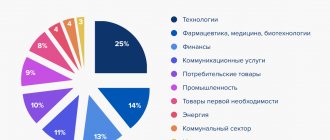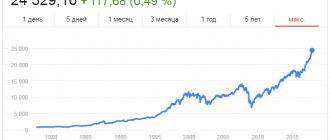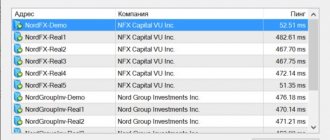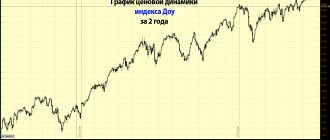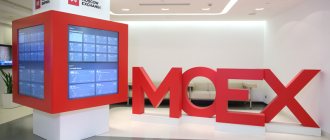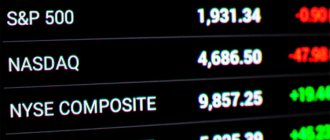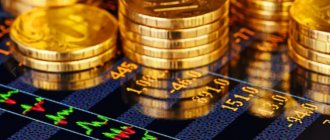Image: Pexels
In articles and programs on economic topics, you can often hear phrases like “the S&P500 index has updated its historical maximum” or “the RTS index fell by 200 points during trading.” Today we will talk about what the actual meaning is behind such information, and how indices are used in real investments.
What are stock indices and why are they needed?
At its core, an index is an indicator of price changes for a certain group of securities.
Roughly speaking, this is a “basket” of shares united on some basis. The set of securities included in the list on which the index is calculated determines what information can be obtained by observing the dynamics of this index. Typically, the purpose of compiling a stock index is to create an indicator with which you can understand the general direction and “speed” of movement of stock quotes of companies in a certain industry.
Studying the dynamics of indices helps participants in exchange trading understand the impact of certain events on quotes - for example, if oil prices rise, it is logical to expect an increase in the value of shares of companies from the field of extraction and processing of energy resources.
At the same time, shares of different companies, even from the same industry, grow at different rates, or may not grow at all or even lose value - the index helps to understand the general trend of the market segment without the need to assess the position of each specific company. Accordingly, different sectors of the economy can be compared by comparing the corresponding stock indices.
US bonds
| Name | Ticker | Short description | Total commission (declared + hidden | Information about the fund |
| VTB – American Corporate Debt Fund | VTBH | High yield bonds of US companies. Contains about 1200 papers. Inside the SHYU ETF - iShares $ High Yield Corp Bond | 0,91 (0,41 + 0,5) | VTBH Review |
| Discovery - US Bonds | OPNU | High yield bonds of US companies. Contains about 1200 papers. Inside the SHYU ETF - iShares $ High Yield Corp Bond | 2,08 (1,58 +0,5) | OPNU Review |
| VTB - American Corporate Debt-Investment Rating | VTBI | Reliable bonds of US companies with a high investment grade rating (AAA - BBB) | 0,44 (0.35 + 0.09) | VTBI Review |
| ATON - Reliable bonds | AMIG | Invests in US corporate securities with investment grade ratings. The portfolio includes more than 2 thousand issues. | 0,69 (0,55 + 0,14) | AMIG Review |
| Finex - US TIPS UCITS ETF | FXTP | Invests in US Inflation Protected Bonds (TIPS) | 0,25 | FXTP Review |
| Finex – RUB US TIPS UCITS ETF | FXIP | Invests in US inflation-protected bonds (TIPS) with ruble hedge | 0,35 | FXIP Review |
What indices exist and how are they calculated?
Each index is designed to solve a specific problem.
These instruments are classified according to various criteria - by calculation method (weighing components), families, and even by author. One of the oldest methods of calculating indices is the arithmetic mean method. For example, the well-known Dow Jones Industrial Average was originally calculated using it. However, in practice, in modern realities, it is ineffective - companies can issue different numbers of shares, some may have millions of them, while others may have tens of thousands. This makes the index value calculated using this method irrelevant.
In the case of Dow Jones, the divisor for calculating the arithmetic average was initially equal to 11 - the number of stocks included in the index. Currently, the calculation uses a scaled average - the sum of prices is divided by a divisor, which changes each time the stocks included in the index are split or merged. This allows, even with changes in the structure of the shares included in the index, to maintain the possibility of comparing them.
Dow Jones Industrial Average chart
The advantage of this approach is the simplicity of calculation, but there are also disadvantages. The main one is the lack of scales. The most expensive stocks influence the index the most. This introduces distortions because the share price is not directly related to the company's capitalization. A company with cheaper shares may be significantly more expensive than an organization with expensive securities.
There are also indices calculated using the arithmetic average formula weighted by the growth rate of stock prices - for example, the Value Line Composite Aithmetic Index (combines 1,700 shares from the NYSE and AMEX). The weight is calculated as follows: the price of each share included in the index is multiplied by a coefficient corresponding to its share in the share capital of the issuing company. This method neutralizes the impact of price dispersion of specific stocks.
Another method for calculating indices is called the geometric mean based on the growth rate of stock prices. The group of indices of this type includes the FT 30 index created by the Financial Times and the Value Line Composite Geometric Index (combines 1,700 shares).
Most foreign and Russian stock indices are based on the value index formula - this includes indices of the Nasdaq, S&P, DAX (Germany), CAC (France), RTS and MICEX indices.
Russian Bond Funds
OFZ
| Name | Ticker | Short description | Total commission (declared + hidden | Information about the fund |
| Sberbank - Moscow Exchange Government Bond Index | SBGB | All issues of government bonds of the federal loan of the Russian Federation (OFZ). The average duration of the fund is 5 years. | 0,8 | |
| REGION – Moscow Exchange Government Bond Index (1-3 years) | SUGB | Government bonds (OFZ) with a duration of 1-3 years. | 0,8 | SUGB Review |
| BSPB - OFZ 1000 | SPBF | As part of OFZ with a duration of 3 years (1000 days). | 0,9 | |
| Ingosstrakh inflationary | INFL | OFZ-in includes government bonds with built-in inflation protection | 0,4 | INFl review |
Corporate
| Name | Ticker | Short description | Total commission (declared + hidden | Information about the fund |
| VTB – Russian corporate bonds smart beta | VTBB | Corporate bonds of the Russian Federation with a duration of 2-3 years. | 0,71 | |
| Sberbank - Moscow Exchange Index of Ruble Corporate Bonds | SBRB | Bonds of Russian companies with a duration of 1-3 years | 0,8 | |
| Gazprombank - Corporate bonds 2 years | G.P.B.S. | Bonds of a Russian company with a duration of 2 years | 0,45 | GPBS/GPBM Review |
| Gazprombank - Corporate bonds 4 years | G.P.B.M. | Bonds of a Russian company with a duration of 4 years | 0,45 | |
| BSPB – Corporate bonds 1000 | SPBC | Includes Russian corporate bonds with a duration of 3 years (1000 days) | 1 | |
| Ingosstrakh – corporate bonds | INGO | High quality Russian corporate bonds (BBB rating) with a duration of 1-3 years | 0,4 | |
| Otkritie – Russian Bonds | OPNB | Corporate bonds of the Russian Federation (from 1 year, rating BB- ... BBB-). The average duration of the fund is 2 years. | 1,31 | OPNB Review |
| Alpha Capital Managed Bonds | AKMB | Bond fund (OFZ, corporate securities) with active management | 1,25 | AKMB Review |
| ATON — Russian bonds+ | AMRB | Bond fund (OFZ, corporate securities) with active management | 0,55 | AMRB Review |
VDO
| Name | Ticker | Short description | Total commission (declared + hidden | Information about the fund |
| ATON – High-yield Russian bonds | AMRH | Ruble high-yield bonds (HYB) of Russian companies. | 0,95 | |
| BKS - SME High Yield Bonds | BCSB | High-yield bonds (HYB) of medium and small companies of the Russian Federation | 1,35 | BCSB Review |
| Tinkoff Bonds RUB | TBRU | High-yield bonds (HYB) of Russian companies of moderate and high creditworthiness | 0.99 | |
| Raiffeisen – High Yield Bonds | RCHY | Ruble high-yield bonds (HYB) of Russian companies. | 0,45 |
Russian Eurobonds
| Name | Ticker | Short description | Total commission (declared + hidden | Information about the fund |
| FinEx Tradable Russian Corporate Bonds UCITS ETF (USD) | FXRU | Eurobonds of the largest Russian companies | 0,5 | |
| FinEx Tradable Russian Corporate Bonds UCITS ETF (RUB) | FXRB | Eurobonds of Russian companies with currency hedging | 0,95 | |
| ITI Funds Russia-focused USD | RUSB | Russian Eurobonds | 0,5 | |
| Sberbank – Moscow Exchange Index of Russian Liquid Eurobonds | SBCB | Eurobonds of Russian companies | 0,8 | |
| RSHB - Russian corporate Eurobonds, vector I.S.G. | PRIE | Eurobonds of Russian companies with high ESG ratings | 0,85 | |
| VTB Russian corp. Eurobonds smart beta | VTBU | Eurobonds of Russian companies | 0,61 | |
| Raiffeisen – Eurobonds | RCMB | Eurobonds of Russian companies | 0,4 | RCMB Review |
Index Families
Some index compilers go beyond just one index and create a whole family of similar tools.
For example, the rating agency Standard & Poor's (S&P) calculates a number of indices, one of the most popular is the S&P 500, which unites the 500 most capitalized US companies (80% are traded on the NYSE, 20% on the AMEX). The Nasdaq exchange has its own family of indices, for example NASDAQ Composite brings together all companies listed on the exchange, and NASDAQ National Market - US companies. Nasdaq indicators take into account the behavior of more than 4,500 US and foreign companies
Among the well-known European families of indices are indicators of the German stock market (DAX 30, Dax Price Index, DAX 100 Sector Indexes, etc.), French CAC - they differ in the number of stocks included in them (40, 80, 120, etc. .).
In Russia, the Moscow Exchange offers its own indices. The most famous are the MICEX and RTS indicators, but there is also an index of blue chips, indices of second-tier shares and the broad market.
Money Market Funds
| Name | Ticker | Short description | Total commission (declared + hidden | Information about the fund |
| FinEx Cash Equivalents UCITS ETF (RUB) | FXMM | Short-term US government bonds (Treasury Bills) with currency hedging | 0.49 | |
| FinEx Cash Equivalents UCITS ETF (USD) | FXTB | Short-term US government bonds (Treasury Bills) in USD | 0.2 | FXTB Review |
| VTB – Liquidity | VTBM | Short repo transactions | 0.5 | VTBM Review |
| Raiffeisen - Money Market Fund | RCMM | Analogue to a bank deposit for short-term placement of free funds | 0.5 | |
| Sber - Savings | SBMM | Short repo transactions | 0,5 |
What do the indices show?
Industry stock indices are needed to create hypotheses about the dynamics of price movements of different companies in the same industry, even those not included in the index itself.
Such indices help investors assess the prospects of investing in companies in a particular sector of the economy at a particular point in time. An example of industry indices is the Dow Jones family, which includes:
- DJIA Industrial Index
is calculated based on the stock prices of the largest companies from leading US industries. - DJTA Transportation Index
covers shares of the largest American transportation companies. - Utility index DJUA
- shares of companies in the electricity and gas supply sector. engaged in gas and electricity supply.
There are also specialized exchanges for companies united on one or another basis.
For example, exchanges where technology companies are traded, like Nasdaq in the US. Often indices are compiled on a regional basis - for example, you can compile lists of shares of companies representing a specific country or group of countries (for example, the European Union). Similar to industry indices, these indicators help investors better understand the state of affairs in the markets of specific regions and countries,
An example of a regional index is Morgan Stanley Capital International (MSCI). There are also indices for individual markets - developed and emerging. For example, the MDCI Developed Market Index includes shares of companies from more than two dozen countries in which stock markets are recognized as developed, and the MSCI Emerging Market Index includes shares of companies from developing countries.
Global equity funds
| Name | Ticker | Short description | Total commission (declared + hidden | Information about the fund |
| FinEx Global Equity UCITS ETF (USD) | FXWO | Global equity fund from 7 countries | 1,36 | FXWO/FXRW Review |
| FinEx Global Equity UCITS ETF (RUB) | FXRW | Global equity fund from 7 countries with currency hedge | 1,36 | |
| Income - Global Small Cap Equities | GSCD | Small cap stocks from different countries | 0,99 |
How investors use indexes
There are several practical uses of the information displayed by stock indices.
First of all, their analysis gives investors an idea of the overall dynamics in certain markets (industries, countries, etc.) and investor sentiment. If the indices of a certain group are growing, it means that investors are positive about the prospects for investing in shares of companies in these industries. Such information can be used to make speculative transactions.
In addition, there are derivative instruments that are based on the index itself - for example, there is a futures contract on the RTS index. Most often, such contracts are used to hedge risks.
In addition to the actual index value, information is published on the total turnover of shares of the companies included in it. Changes in these figures make it possible to judge the general activity of traders in the market when dealing with securities of a certain type.
In the case of country indices, studying them over a long period helps to get an idea of the investment climate in a particular country.
Real estate
| Name | Ticker | Short description | Total commission (declared + hidden | Information about the fund |
| FINEX - Shares of US real estate investment trusts | FXRE | Invests in US real estate trusts (REITs). Consisting of 130 companies. By law, REITs must pay out 90% of their income as dividends. | 0,6 | FXRE Review |
How else to make money on the index: we work with ETFs
For private investors, investing directly in indexes is not a realistic option, since they include many companies whose shares can be expensive.
To use the conditional S&P500, you will need to buy shares of all companies in the appropriate proportion, this requires millions of dollars. In order to use indices without the need for such huge investments, the ETF (Exchange Traded Funds) tool was created. In essence, these are foreign exchange-traded investment funds, which represent a portfolio of shares or other assets that completely replicate the composition of the target index. For example, an ETF with the ticker SPY reflects the performance of stocks in the S&P500 index. Shares of the ETFs themselves are also traded on the exchange.
ETF SPY chart
The main advantage of working with ETFs is simplicity. They are traded like ordinary shares; a regular brokerage account is suitable for their purchase, which can be opened online through State Services; their use does not require significant initial investments. The investor has a complete understanding of what securities are included in the ETF - to do this, just look at the index on which this financial instrument is based.
ETF trading for RTS and Eurobond indices has been taking place on the Moscow Exchange stock market since the spring of 2022. These and other ETFs can be used by ITI Capital clients to implement investment strategies.
What instruments are included in ETFs
The fund's portfolio may consist of any instruments traded on an exchange. For example, stocks, bonds, currencies, precious metals. Their ratio depends on the fund's strategy. Once at a certain period, the management company reviews the portfolio and rebalances, that is, sells some assets and buys others.
All actions are subject to strict rules from which managers cannot deviate. All information about the composition of the ETF and the frequency of portfolio rebalancing is available in the fund’s documentation.
ETFs can consist of securities, precious metals, derivatives - there are practically no restrictions. That's why today there are thousands of funds with very different structures. For example, there is the Global X Millennials ETF - a fund for shares of brands loved by millennials. Or the Direxion Work From Home ETF, which invests in services that benefit from the widespread shift to remote work.
Depositories
We have already said above that they are assigned the role of regulatory authorities ; all transactions go through them. ETFs cannot operate without depositories.
In the USA these bodies are:
- Goldman Sachs;
- Smith Barney;
- Merrill Lynch.
In Europe :
- Commerzbank;
- Credit Suisse;
- UniCredit Bank;
- Banca IMI.
This is not a complete list. Any large investment bank can apply for the role of depository.
Structured products of PBIF from Tinkoff Investments.
In December 2022, Tinkoff Investments launched its own mutual funds, the so-called “perpetual portfolio” strategies. What does this mean?
As the most legendary investor of our time, Warren Buffett, says about his favorite investment strategy, it is to buy stocks “forever.”
It’s the same with Tinkoff mutual funds, they suggest that if you want to invest your funds, it is better to do it for the longest possible period, and in order for your funds to be safe, they offer various investment strategies, which will be closer to you, decide for yourself.
There are only 3 of them so far:
- Tinkoff – Perpetual Portfolio Strategy RUB – TRUR .
- TUSD Perpetual Portfolio Strategy .
- Tinkoff – EUR – TEUR .
BPIFs include investments in US and Russian index funds, various bonds, and gold, all of which together should give a good return on the portfolio with good investment security.
Of course, the fund's commissions leave much to be desired; currently they amount to 2.4% per year + 10% of the profit received. But, on the other hand, if the profit is good, then the size of the commission will not be noticeable to the investor.
As you can see for yourself, although there are not many ETFs and mutual funds on the Russian market, their number has doubled in 2022, which means that these instruments are in great demand, and I think over time there will be much more of them.
